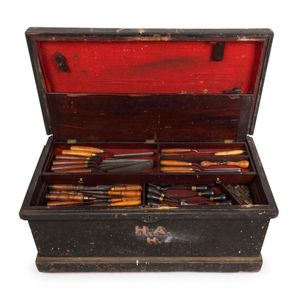19th Century Pattern Maker's Tool Chest with Tools
A superb fully fitted pattern maker's tool chest, late 19th century, of cedar and pine construction with iron carrying handles, black japanned finish and pattern maker's initials to the face, 'H. A. H.'. Two large storage compartments to the inside base of the chest with four graduated sliding trays with fitted dividers and brass bow head drawer pulls. A fine chest with a very comprehensive array of original hand tools stamped with the pattern makers name 'H. Armstrong', of note, 13 ebony handled gauge carving chisels made by 'W. Marples & Sons', 12 stepped gauge chisels also made by 'W. Marples & Sons', a nickel plated brace drill with rosewood handles, 12 boring drill bits and rolled drill pouch with 31 various countersink and plug bits made by 'P. Peston, Sheffield', numerous measuring tools and compass', 20 other chisels of various styles. The chest 46 cm high, 91.5 wide, 46 cm deep.
You must be a subscriber, and be logged in to view price and dealer details.
Subscribe Now to view actual auction price for this item
When you subscribe, you have the option of setting the currency in which to display prices to $Au, $US, $NZ or Stg.
This item has been sold, and the description, image and price are for reference purposes only.
- Ebony - Ebony is a close grained timber, black in colour. It has a fine texture which can be polished to a high gloss, making it suitable for venereering, inlay and stringing and its use as solid timber is resticted to small decorative items and ornamental decoration, such as chess pieces and musical instrument parts. The term "ebonised" means "faux ebony", timber that has been darkened during the polishing process to resemble ebony.
- Rosewood - A dense timber that varies in shade to very light brown to almost black. When rosewood is cut and sanded the colour of the timber will turn black, and after polishing and exposure to daylight, the surface will gradually lighten over time to light brown with black streaks.
The name comes from the odour emanating from the timber when it is planed, sanded or cut.
Rosewood was very popular for use in Victorian furniture in the second half of the 19th century, and at that time most of the rosewood was imported from Brazil. However it also grows in India and Indonesia.
It is used in the sold for chairs and table legs, but for carcase furniture such as side cabinets and bookcases, and for table tops it is always used as a veneer. - Japanning - Japanning is the early eighteenth century technique used by European craftsmen to imitate the oriental style lacquer work that became popular in England, France, the Netherlands, and Spain in the 17th century.
The lacquer used was based on the lac beetle dissolved in alcohol (as used in French polish) and differed from the Chinese lacquer which was based on tree sap.
Each layer of the lacquer was allowed to dry and then sanded down. It was applied over cream, yellow, green, red, or black grounds. Japanning using gold leaf was also widely used with lacquer work. The technique can be found on bureaux, cabinets, chests, longcase clocks, and chairs.
This item has been included into following indexes:
- woodworking tools, makers - Marples 19
- woodworking tools, other
